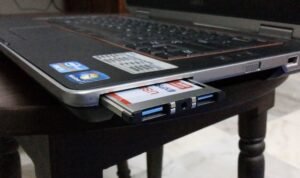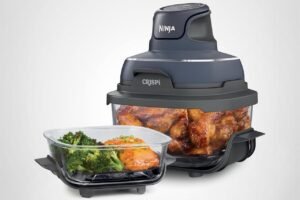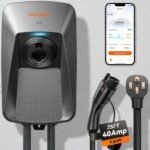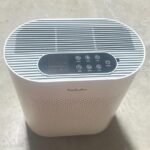Teachers ask a lot from a laptop: you’re juggling lesson plans, 20+ tabs, Zoom/Teams, Google Classroom, grading in spreadsheets, maybe a document camera or projector, and you still need enough battery to make it through back-to-back periods. This guide narrows the field to five dependable Windows laptops that fit a teacher’s day, then walks you through exactly what specs to prioritize so you buy once and teach happily for years.
In this guide we cover (and recommend):
- Microsoft Surface Laptop (2024, Copilot+ PC) — Best overall for most teachers thanks to battery life, speed, and light weight.
- Acer Aspire Go 15 (AG15-42P) — Best value 15-inch for multitasking on a budget.
- Lenovo IdeaPad Slim 3 (15″) — Best for power users who keep 30 tabs and big spreadsheets open.
- Dell Inspiron 15 (15.6″) — Best for ports and campus projector compatibility.
- HP 15 (15.6″) — Best “no-frills” 15-inch with a friendly price and familiar layout.
TL;DR: The Short List
- Best overall (K-12 & higher-ed): Microsoft Surface Laptop (2024, 13.8″) — excellent battery life, crisp 120 Hz touch display, fast new Snapdragon X chips, and a great keyboard for long grading sessions. If you teach in multiple rooms, the weight and stamina are clutch.
- Best value 15-inch: Acer Aspire Go 15 (AG15-42P) — practical performance (Ryzen 7 5825U), solid 16 GB/512 GB baseline on many configs, Wi-Fi 6, and a straightforward FHD IPS screen. Ideal if you want a bigger display without overspending.
- Best for heavy multitasking: Lenovo IdeaPad Slim 3 (15″) — commonly sold with high-core-count CPUs and generous memory upgrades. Great for big assessment files, video clipping, or running multiple LMS windows.
How to Choose a Teacher Laptop (What Actually Matters)
Below are the criteria we used to pick our five, and how to think about them for your classroom.
1) Screen: 13–15 inches, FHD+ IPS, decent brightness
- Size: 13–14″ is perfect for mobility. 15–16″ is better if you live in spreadsheets or need side-by-side windows.
- Resolution & panel: Aim for at least 1920×1080 (FHD) on an IPS panel for legibility and viewing angles when students gather around your desk.
- Refresh rate & touch: A smoother 120 Hz panel (like Surface Laptop) feels nicer when scrolling long docs; touch is useful for quick annotations.
2) Performance: modern mid-range beats old high-end
- CPUs to look for: Intel Core Ultra/Core 5 (2024+), AMD Ryzen 5/7 5000–7000 series, or the new Qualcomm Snapdragon X (Copilot+ PCs) for long battery life and snappy everyday speed.
- RAM: 16 GB is the sweet spot for teachers (multiple tabs, Zoom/Teams, and Office/Docs).
- Storage: 512 GB SSD gives breathing room for videos, student projects, and offline content.
3) Battery life: plan for a real school day
If you roam between rooms or supervise after-school activities, aim for laptops claiming 15 hours or more of local video. You’ll see less in mixed use, but higher claims usually correlate with stronger real-world stamina.
4) Ports & connectivity: HDMI/USB-C and Wi-Fi 6+
- USB-C (preferably with charging/display): simplifies travel chargers and docks.
- HDMI or easy USB-C-to-HDMI: projectors and older displays are common on campus.
- Wi-Fi 6 or 6E: better connectivity in crowded networks (staff room, assembly hall).
- Quiet bonus: an SD/microSD slot helps move photos/videos.
5) Camera & mics: look and sound clear for remote days
A 1080p webcam and dual mics make a big difference for parent conferences and hybrid learning. Features like auto-framing, noise reduction, and voice focus are nice quality-of-life upgrades.
6) Keyboard & trackpad: comfort matters
You’ll be typing comments and feedback for hours. Prioritize a comfortable keyboard with good key travel and a large, precise touchpad.
7) Weight & build
Under 3.5 lb (1.6 kg) is a treat if you move between buildings. Aluminum or well-finished plastic both work—what matters is hinge feel and overall rigidity.
The Best Laptops for Teachers in 2025
Below, we profile each pick, focusing on real classroom life—not just benchmarks. Where configurations vary by seller, we call out representative specs. Always verify the exact SKU you’re buying.
1) Microsoft Surface Laptop (2024, Copilot+ PC) — Best Overall for Most Teachers
Why it’s great:
The 13.8″ Surface Laptop hits the teacher trifecta: light, long-lasting, and delightfully smooth. The PixelSense Flow touchscreen (up to 120 Hz) keeps scrolling, writing, and window management fluid; the Snapdragon X Elite/Plus chips are fast but sip power; and the keyboard is among the most comfortable on any Windows laptop. Battery life claims are class-leading for typical productivity. If you’re bouncing between classrooms—or you just prefer lighter bags—this is the easy, no-drama choice.
Who it’s for:
Teachers who value portability and stamina: English, history, language, or any subject where you’re constantly reading, annotating, and presenting.
Key specs to expect (typical configs):
- 13.8″ PixelSense Flow touch, 2304×1536, up to 120 Hz, bright and sharp
- Snapdragon X Plus (10-core) or X Elite (12-core); NPU for Windows AI effects (autoframing, voice focus, live captions, etc.)
- 16–32 GB LPDDR5x RAM, 256 GB–1 TB storage
- 2× USB-C (USB4), 1× USB-A, Surface Connect
- Excellent battery life for everyday use
Classroom advantages:
- Sustained battery across a full day, often with juice to spare
- Quiet, cool operation—great in silent rooms
- Sharp, bright screen for projecting and small-group demos
- Windows Studio Effects can clean up video and audio on calls automatically
Consider before you buy:
- Some older x86 apps may run under emulation on Snapdragon with a performance/battery hit; common teaching apps (Office, Edge/Chrome, Zoom/Teams, Canvas/Google Classroom) are fine. If you depend on legacy plug-ins or niche drivers, verify compatibility first.
2) Acer Aspire Go 15 (AG15-42P) — Best Value 15-inch
Why it’s great:
When you want a larger screen for side-by-side grading and lesson planning—without overspending—the Aspire Go 15 balances price and practicality. Many current configs pair a Ryzen 7 5825U with 16 GB RAM and a 512 GB SSD, giving more than enough headroom for modern classroom multitasking. The 15.6″ FHD IPS panel is easy on the eyes, and you get Wi-Fi 6 for busy school networks.
Who it’s for:
Teachers who prefer a full-size keyboard area and wider canvas (math/science spreadsheets, rubrics, and reference windows), or who connect with an HDMI/USB-C display at their desk.
Key specs to expect (AG15-42P configurations):
- 15.6″ FHD (1920×1080) IPS display
- AMD Ryzen 7 5825U, integrated Radeon graphics
- Typical 16 GB RAM / 512 GB SSD configurations; Wi-Fi 6
- Solid everyday battery life; straightforward port selection (varies by SKU)
Classroom advantages:
- Big enough to keep two documents side-by-side for grading
- Strong multi-core CPU handles tabs, streaming, and Office/Docs with ease
- Value pricing keeps budget committees happy
Consider before you buy:
- Brightness and speakers tend to be basic on value models; plan to present via classroom speakers/projector when possible
- Check the exact SKU for port layout (USB-C charging, HDMI, etc.) since Aspire Go variants differ by region and retailer
3) Lenovo IdeaPad Slim 3 (15″) — Best for Heavy Multitasking
Why it’s great:
IdeaPad Slim 3 listings frequently pack high-core-count CPUs and generous RAM options; combined with a clean 15-inch FHD display, it’s a smart pick for teachers who keep a dozen big apps open, record screen captures, or process large media files for class.
Who it’s for:
Power users: department heads, tech leads, or anyone often juggling screencasts, big spreadsheets, PDF annotation, and LMS admin in the same session.
Key specs to expect (varies by config):
- 15″ FHD/FHD+ display
- Up to Core i7-13620H in many listings, DDR5 memory (commonly 16–32 GB)
- 1 TB SSD options are common
- Wi-Fi 6, Bluetooth 5.x; USB-C and HDMI vary by exact model/SKU
Classroom advantages:
- Plenty of CPU headroom for simultaneous apps (Grammarly, Notion/OneNote, Canvas/Google Classroom, YouTube, and a doc camera tool)
- Easy to spec with more RAM so it stays fast for years
Consider before you buy:
- IdeaPad Slim 3 spans many sub-models and regions—double-check specs (screen brightness, USB-C charging, and webcam) before purchasing
4) Dell Inspiron 15 (15.6″) — Best for Ports & Projectors
Why it’s great:
Inspiron 15 models sold online often emphasize practical specs and ports at sensible prices. Typical listings feature a 15.6″ FHD IPS display, plenty of RAM/SSD for multitasking, and HDMI/USB-A alongside USB-C—handy if your campus has older projectors or you rely on a clicker/USB receiver.
Who it’s for:
Teachers who frequently plug into projectors, swap USB drives, or use wired peripherals and want a familiar 15-inch layout with numeric keypad.
Key specs to expect (example listing):
- 15.6″ FHD IPS display (touch on some SKUs)
- Mid-range Intel Core i5/i7 options; 16–32 GB RAM, 512 GB–1 TB SSD
- HDMI, USB-A, and USB-C for broad compatibility; Windows 11
Classroom advantages:
- Great port variety for projectors/document cameras without always needing a dongle
- Familiar keyboard with numpad for grading
Consider before you buy:
- Retailer-upgraded SKUs on marketplaces can mix generations; verify CPU generation, screen type, and warranty so you know exactly what you’re getting
5) HP 15 (15.6″) — Best “No-Frills” 15-inch for Tight Budgets
Why it’s great:
HP’s 15-inch line is widely available and priced for tight school budgets, with straightforward configurations and a comfortable full-size layout. Official models pair modern Intel Core chips with FHD displays and sensible storage options; marketplace bundles vary more widely, so double-check the details.
Who it’s for:
Educators who want a clean, familiar 15-inch laptop for Docs/Slides/Sheets, Zoom/Teams, and everyday admin, at an approachable price.
Key specs to expect (official HP 15 examples):
- 15.6″ FHD display
- Intel Core 5 / Core i5 options; 8–16 GB RAM, 256–512 GB SSD
- Wi-Fi 6, USB-C/USB-A; Windows 11 Home or Pro depending on SKU
Classroom advantages:
- Simple to deploy, easy to use, no learning curve
- Often the lowest price among major brands at the 15-inch size
Consider before you buy:
- Some budget SKUs ship with 8 GB RAM and limited storage—prefer 16 GB/512 GB if you can stretch
At-a-Glance Comparison (Representative Configs)
Specs vary by retailer/SKU; use this table as a buying compass and verify the exact configuration before checkout.
| Model | Screen | CPU Class | Memory/Storage (common) | Notable strengths |
|---|---|---|---|---|
| Surface Laptop (2024, 13.8″) | 13.8″ 2304×1536, up to 120 Hz touch | Snapdragon X Plus/Elite (Copilot+) | 16–32 GB / 256 GB–1 TB | Light, long battery, premium screen & keyboard |
| Acer Aspire Go 15 (AG15-42P) | 15.6″ FHD IPS | AMD Ryzen 7 5825U | 16 GB / 512 GB | Best budget 15″ with strong everyday speed |
| Lenovo IdeaPad Slim 3 (15″) | 15″ FHD/FHD+ | Intel Core i7-13620H (examples) | 16–32 GB / up to 1 TB | Muscle for heavy multitasking and large files |
| Dell Inspiron 15 (15.6″) | 15.6″ FHD IPS (some touch) | Intel i5/i7 (varies) | 16–32 GB / 512 GB–1 TB | Ports for projectors & peripherals, familiar layout |
| HP 15 (15.6″) | 15.6″ FHD | Intel Core 5 / Core i5 | 8–16 GB / 256–512 GB | Friendly price, easy to deploy |
Buying Advice by Teaching Scenario
Elementary (K-5):
You’ll benefit most from a light laptop with great battery because you move a lot (carpet time to centers to specials). Surface Laptop shines here. If you want a bigger screen for ReadWorks/EP assignments side-by-side, the Aspire Go 15 or HP 15 is sensible.
Middle & High School Math/Science:
You’re often in Sheets/Excel, Desmos, simulations, and maybe data-logging. A 15-inch screen helps, plus reliable HDMI/USB-C for projectors. IdeaPad Slim 3 or Dell Inspiron are comfortable choices.
Humanities/Language Arts:
Keyboard quality and eye-friendly display matter as you mark essays. Surface Laptop’s keyboard + 120 Hz screen make long grading sessions less fatiguing.
World Languages & ESL/ELL:
Clear mics and stable Wi-Fi are key for oral practice and streaming. Any pick works; camera effects that tidy video/audio help polish remote interactions.
Art/Design/Yearbook Advisors:
If you edit images or video clips frequently, lean toward a higher-core CPU (IdeaPad Slim 3) or plan to plug into a more powerful desktop for heavy work.
Traveling/Itinerant Specialists (SPED, OT, SLP):
Weight and battery first: Surface Laptop. If you carry lots of local media, ensure 512 GB+ storage.
Detailed Criteria (What We Looked For)
Performance tiers we trust
- Great everyday experience: Ryzen 5/7 (5000–7000U), Intel Core 5/Core i5 (12th–14th gen and newer), and Snapdragon X Plus/Elite.
- Why Snapdragon X matters: Copilot+ PCs add a dedicated NPU for live captions, voice focus, and other effects while staying efficient—nice quality-of-life upgrades for hybrid days.
Memory & storage
- 16 GB RAM keeps Chrome tabs + video calls + Docs/Slides from stuttering.
- 512 GB SSD gives room for curriculum videos, assessments, and archived student work. If you rely on cloud only, 256 GB works—just budget for a portable SSD.
Displays & eyestrain
- Prefer IPS over TN and look for 300+ nits if you teach in bright rooms. High-refresh panels (like 120 Hz) make scrolling lengthy PDFs and sites easier on the eyes.
Ports & dongles
- USB-C with DisplayPort/charging reduces cable clutter. HDMI is still everywhere in schools; models like the Inspiron 15 often include it.
Battery & thermals
- Copilot+ laptops lead battery charts for office workloads; Ryzen U-series is also efficient. Prioritize models known for quiet, cool operation in silent classrooms.
The Picks in Practice (Mini-Reviews)
Microsoft Surface Laptop (2024, 13.8″) – Our Top Pick
Working teachers notice two things immediately: it lasts and it feels premium. The screen is bright and fast, so scrolling long PDFs or slides is smoother and less fatiguing. The keyboard makes marathon feedback sessions tolerable, and the webcam/mics produce a reliably professional look/sound for parent meetings or virtual days. If you teach in multiple rooms, the weight and battery alone justify the choice. The only audience that should hesitate is anyone with niche, older Windows apps or drivers—compatibility is broadly good, but you’ll want to verify edge cases given the ARM architecture.
Pros
- Exceptional battery life for productivity use
- Smooth 120 Hz touch display; accurate color
- Great keyboard/trackpad and light carry weight
- Quiet, cool under everyday loads
Cons
- Some legacy x86 apps/drivers may be imperfect under emulation
- Limited port selection vs. larger 15-inch classmates
Acer Aspire Go 15 (AG15-42P) – Big Screen Value
The Aspire Go 15 makes a strong case as a budget-friendly 15-inch. The Ryzen 7 5825U is tried-and-true: quick for tabs, streaming, Docs, and multi-window work. Many listings hit a healthy 16 GB/512 GB baseline, avoiding the bottlenecks that plague cheaper laptops. It’s not a premium ultrabook—the speakers and brightness are fine rather than flashy—but in a classroom where you’re projecting or using external audio, that’s a fair trade.
Pros
- Plenty of CPU headroom and memory for real multitasking
- 15.6″ FHD IPS is spacious and legible
- Wi-Fi 6 helps in crowded school networks
Cons
- Average speakers/brightness; check exact SKU for port set and USB-C charging details (they vary)
Lenovo IdeaPad Slim 3 (15″) – Power on a Budget
If your day includes video snippets, big Sheets workbooks, and lots of background apps, the IdeaPad Slim 3’s frequent high-core CPUs plus plentiful RAM make it easy to keep everything open without slowdowns. Pick a config with at least 16 GB RAM and you can blast through a heavy grading week. As with many IdeaPad models, sub-model differences exist—brightness, webcam options, or USB-C charging—so verify the exact version.
Pros
- Strong multi-core performance
- Easy to find with larger RAM/SSD options
- Excellent for “many windows, many tabs” teachers
Cons
- Model variance: confirm display brightness and port features before buying
Dell Inspiron 15 (15.6″) – Ports and Familiarity
Dell’s Inspiron 15 line is a comfort pick when your environment has legacy projectors and USB accessories. Many configurations combine FHD IPS displays with HDMI, USB-A, and USB-C, plus roomy RAM/SSD kits for an all-rounder that just works on campus. It won’t feel as svelte as a premium ultrabook, but it’s honest, practical, and easy to support.
Pros
- HDMI and USB-A make projector life easier
- Numpad for grades; capacious memory/storage options
- Straightforward to set up for staff who prefer a classic layout
Cons
- Marketplace SKUs can mix generations—double-check CPU, panel type, and warranty details
HP 15 (15.6″) – The Friendly, Budget 15-Inch
The HP 15’s appeal is its familiar layout and wide availability. Official store models with modern Intel Core chips and FHD screens are the safest bet, while third-party bundles range from “great value” to “overstuffed specs with old CPUs,” so read closely. For a tight budget that still needs a full-size keyboard and solid day-to-day speed, HP 15 is a sensible pick—just prioritize 16 GB RAM / 512 GB SSD if possible.
Pros
- Easy to buy and support across districts
- Simple 15-inch design with decent connectivity
- Priced right for budget approvals
Cons
- Entry models ship with 8 GB/256 GB—upgrade if you can (you’ll feel the difference)
Frequently Asked Questions (Teacher Edition)
Q1) Is 8 GB of RAM enough?
It works, but Chrome/Edge + Zoom + Docs/Slides + Sheets can bog down. 16 GB is the right call for a smooth, frustration-free experience.
Q2) 256 GB vs 512 GB storage?
If you store videos offline or keep multi-year curriculum archives, go 512 GB. Cloud-heavy workflows can live on 256 GB, but you’ll manage space more often.
Q3) Do I need a touchscreen?
It’s not mandatory, but touch helps when zooming/panning worksheets, annotating PDFs, or tapping on the fly (Surface Laptop nails the feel).
Q4) What about Chromebooks?
Chromebooks are budget-friendly and great for Google Classroom, but Windows laptops are more flexible with desktop apps (Office, specialty software, drivers for doc cams, etc.). If your district is Google-first and entirely web-based, a Chromebook may suffice; otherwise, Windows gives you fewer roadblocks.
Q5) Are the new Copilot+ PCs worth it for teachers?
For many, yes—because they’re efficient and fast with excellent battery life, and Windows’ AI features (autoframing, noise cleanup, live captions) are helpful in hybrid settings. Just verify any legacy x86 software you depend on.
Setup Tips for a Smooth First Week
- Update Windows and drivers on day one.
- Turn on Windows Hello (face or fingerprint) to speed logins between classes.
- OneDrive or Google Drive: pick one for auto-backup of grades and lesson plans.
- Power & battery: enable auto power saver when unplugged so you never hunt for an outlet mid-period.
- Classroom I/O kit: toss a USB-C hub with HDMI, a spare 65 W USB-C power adapter, and a microfiber cloth in your bag.
- Privacy: if using a Copilot+ PC, decide whether to enable/disable Windows Recall (opt-in; follow your school’s policy).
Final Recommendations (Make the Choice Simple)
- Want the least hassle and the longest battery? Pick Microsoft Surface Laptop (2024). You’ll enjoy the most “premium” daily experience and carry less charger anxiety.
- Want a bigger 15-inch screen that won’t wreck your budget? Get Acer Aspire Go 15 (AG15-42P). It’s the right balance of speed, size, and price.
- Juggle heavy, multi-window workloads? Choose Lenovo IdeaPad Slim 3 (15″) with ample RAM; it’s built for tab-hungry days.
- Plug into lots of projectors and peripherals? Dell Inspiron 15 keeps you cable-compatible out of the box.
- Need a familiar 15-inch at the lowest cost? HP 15 is a safe, friendly option—just aim for 16 GB RAM / 512 GB SSD when you can.











